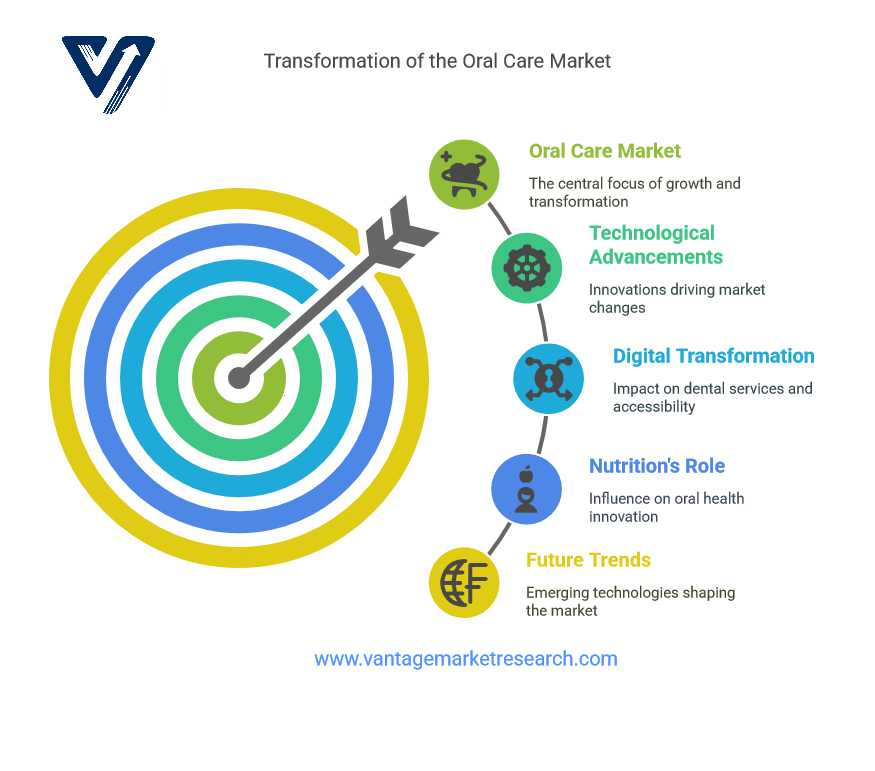Innovations and Trends in the Oral Care Market
The oral care market is experiencing a significant transformation, driven by technological advancements and a growing awareness of the importance of oral health. According to analysts at Vantage Market Research, the global Oral Care Market is valued at USD 42.45 Billion in 2024 and is projected to reach a value of USD 86.8 Billion by 2035, with a Compound Annual Growth Rate (CAGR) of 6.75% between 2025 and 2035. This research report explores various innovations in home oral care products, the impact of digital transformation on dental services, the role of nutrition in oral health innovation, and future trends in oral care technologies.

Innovation in Home Oral Care Products
The evolution of home oral care products has been remarkable, particularly in the areas of fluoride technology, smart toothbrushes, and mobile app integration. Advances in fluoride technology have led to the development of more effective toothpaste and mouth rinses that not only prevent cavities but also strengthen enamel. These innovations are crucial as they provide consumers with enhanced protection against dental decay, which remains a significant concern globally.
Smart toothbrushes have emerged as a game-changer in personal oral hygiene. Equipped with sensors and connectivity features, these devices can track brushing habits, provide real-time feedback, and even connect to mobile applications for a more comprehensive oral care routine. Users can receive reminders for brushing, flossing, and even scheduling dental appointments, making oral care more interactive and engaging.
The integration of mobile apps into oral care routines has further revolutionized how individuals approach their dental health. These apps often include educational resources, gamified experiences for children, and personalized care plans based on individual needs. As a result, consumers are more informed and proactive about their oral health, leading to better outcomes.
Impact of Digital Transformation on Dental Services
Digital transformation is reshaping dental services, making them more accessible and efficient. Tele-dentistry and remote consultations have gained traction, particularly in the wake of the COVID-19 pandemic. Patients can now consult with dental professionals from the comfort of their homes, reducing the need for in-person visits and making dental care more convenient.
Online platforms for patient education have also become essential tools for dental practices. These platforms provide valuable information on oral hygiene, preventive care, and treatment options, empowering patients to take charge of their dental health. By enhancing patient knowledge, dental professionals can foster a more collaborative relationship with their patients.
Moreover, enhanced data analytics is playing a pivotal role in personalized care. By analyzing patient data, dental practices can tailor treatment plans to meet individual needs, improving patient outcomes and satisfaction. This data-driven approach allows for more precise diagnostics and targeted interventions, ultimately leading to better oral health for patients.
Role of Nutrition in Oral Health Innovation
Nutrition plays a critical role in oral health, and recent innovations in nutritional products are addressing this connection. Research has shown that certain dietary choices can significantly impact dental health, leading to the development of specialized nutritional products designed to support oral hygiene. These products often contain ingredients that promote enamel strength and reduce the risk of cavities.
Additionally, research on sugar substitutes and their effects on oral health has gained momentum. As the consumption of sugar continues to be a leading cause of dental issues, understanding the impact of alternative sweeteners is crucial. Studies are exploring how these substitutes can provide sweetness without the detrimental effects on teeth, paving the way for healthier dietary options.
Dietary guidelines aimed at preventing oral diseases are also evolving. Health organizations are increasingly emphasizing the importance of a balanced diet rich in vitamins and minerals that support oral health. By promoting awareness of these guidelines, individuals can make informed choices that contribute to better dental health.
Future Trends in Oral Care Technologies
The future of oral care technologies is promising, with several trends poised to shape the industry. The evolution of antimicrobial treatments is one such trend, as researchers continue to explore new compounds that can effectively combat oral bacteria and reduce the incidence of gum disease and cavities.
3D printing is revolutionizing the production of dental prosthetics, allowing for customized solutions that fit patients perfectly. This technology not only enhances the efficiency of dental practices but also improves patient comfort and satisfaction.
AI-driven diagnostics and treatment plans are also on the horizon. By leveraging artificial intelligence, dental professionals can analyze patient data more effectively, leading to quicker and more accurate diagnoses. This technology has the potential to streamline treatment processes and improve overall patient care.
In conclusion, the oral care market is undergoing significant changes driven by innovation and technology. From advancements in home care products to the impact of digital transformation and nutrition, the future of oral health looks bright. As these trends continue to evolve, they promise to enhance the way individuals approach their dental health, leading to improved outcomes and a greater emphasis on preventive care.
FAQs.
- What factors are driving the growth of the global Oral Care Market?
- How is the Compound Annual Growth Rate (CAGR) calculated for the Oral Care Market?
- What are the projected market values for Oral Care in 2024 and 2035?
- Which regions are expected to see the most growth in the Oral Care Market?
![[Market Research Reports] – Research Google News Blog | VMR.Biz](https://www.vmr.biz/wp-content/uploads/2022/12/logo-removebg-preview.png)











